Click here to download a copy of the PDF 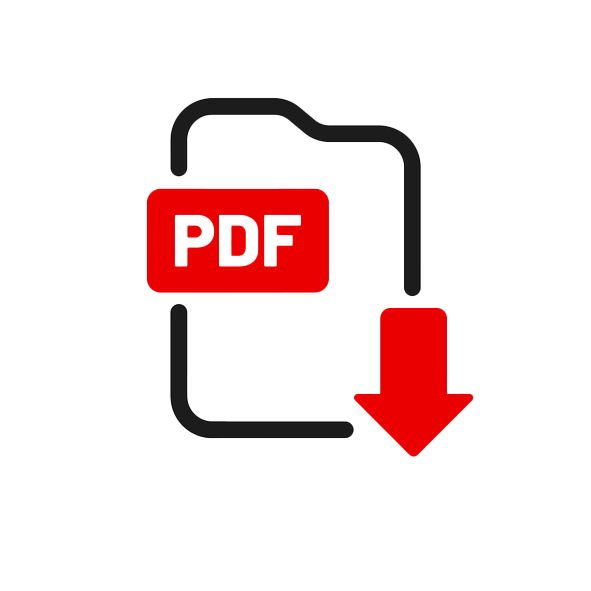




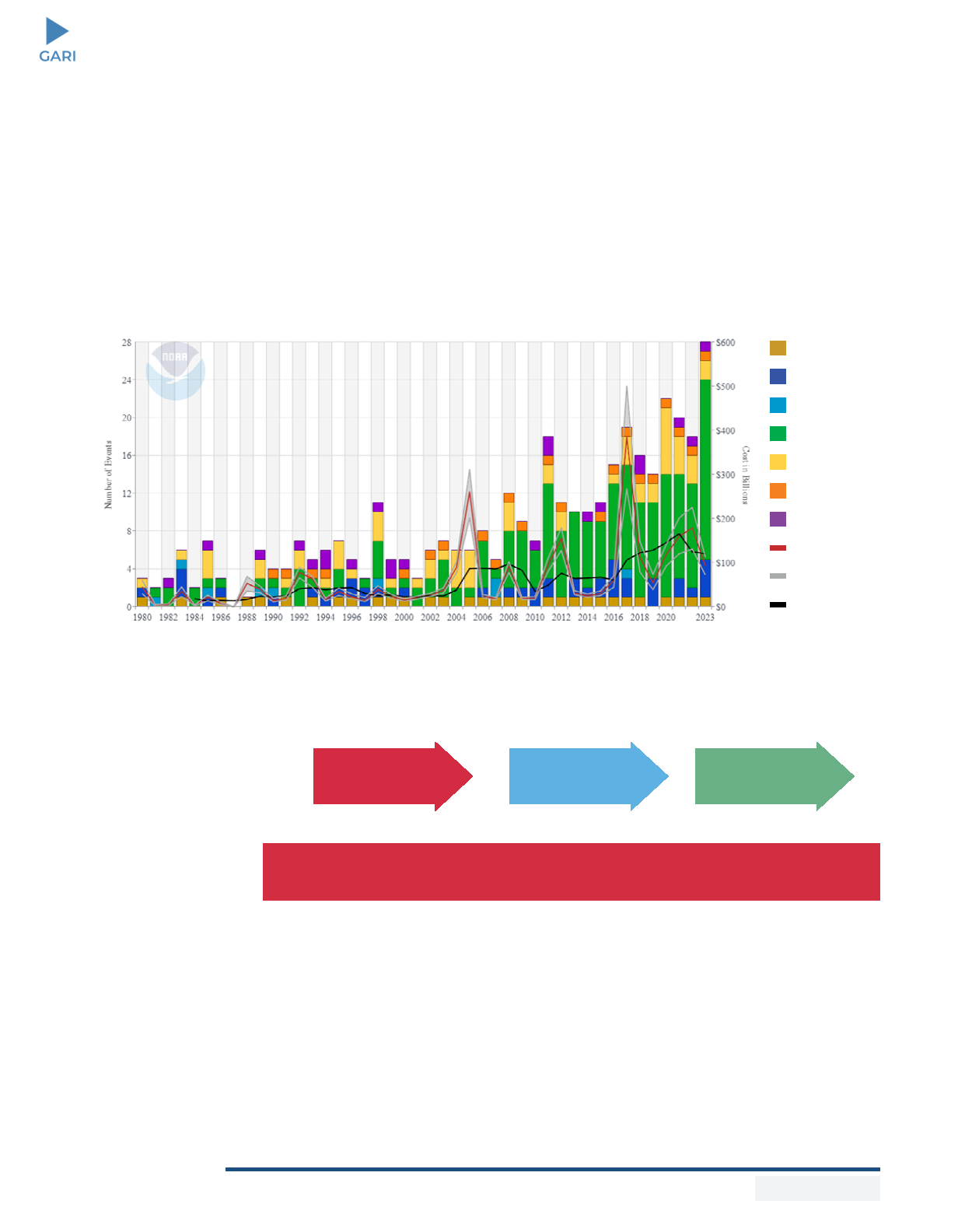

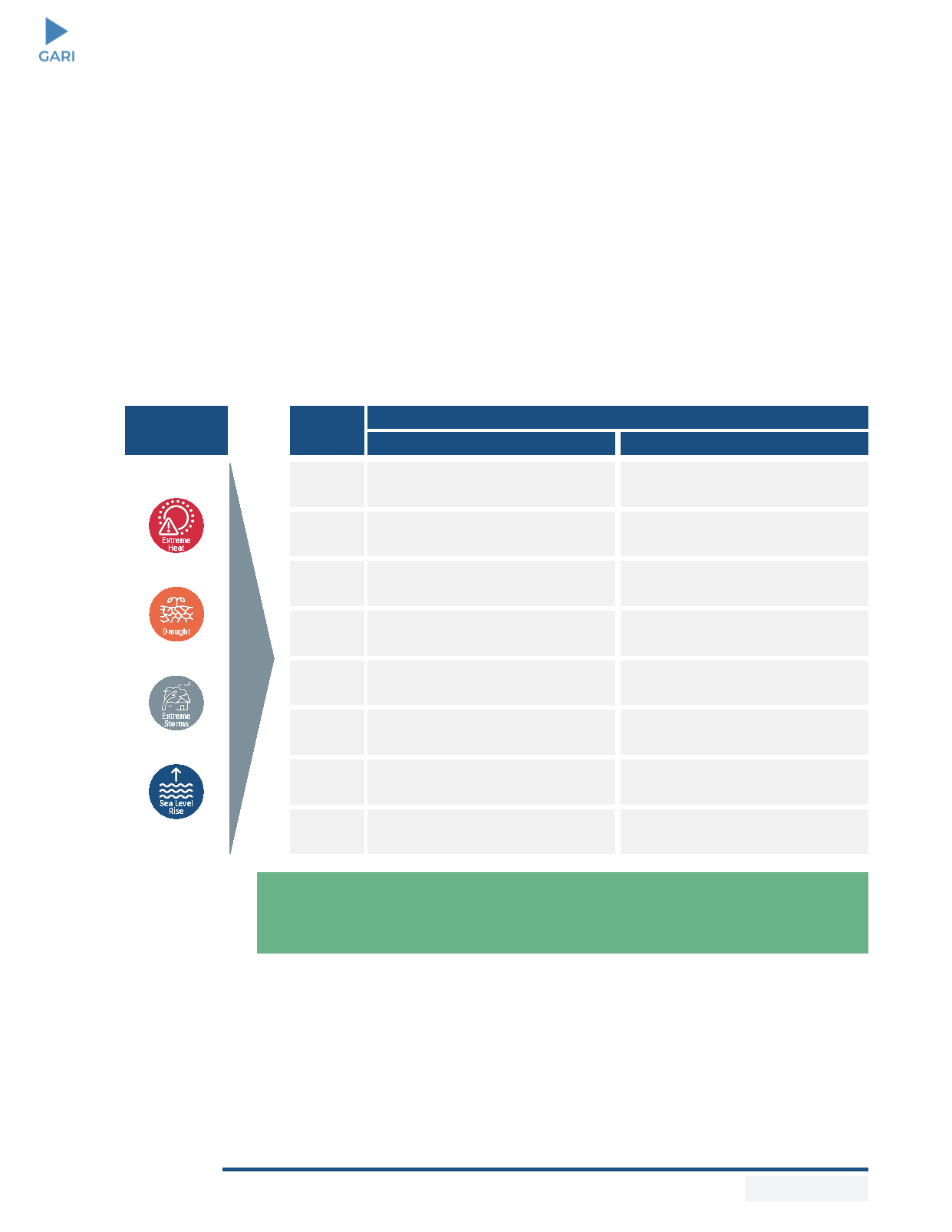


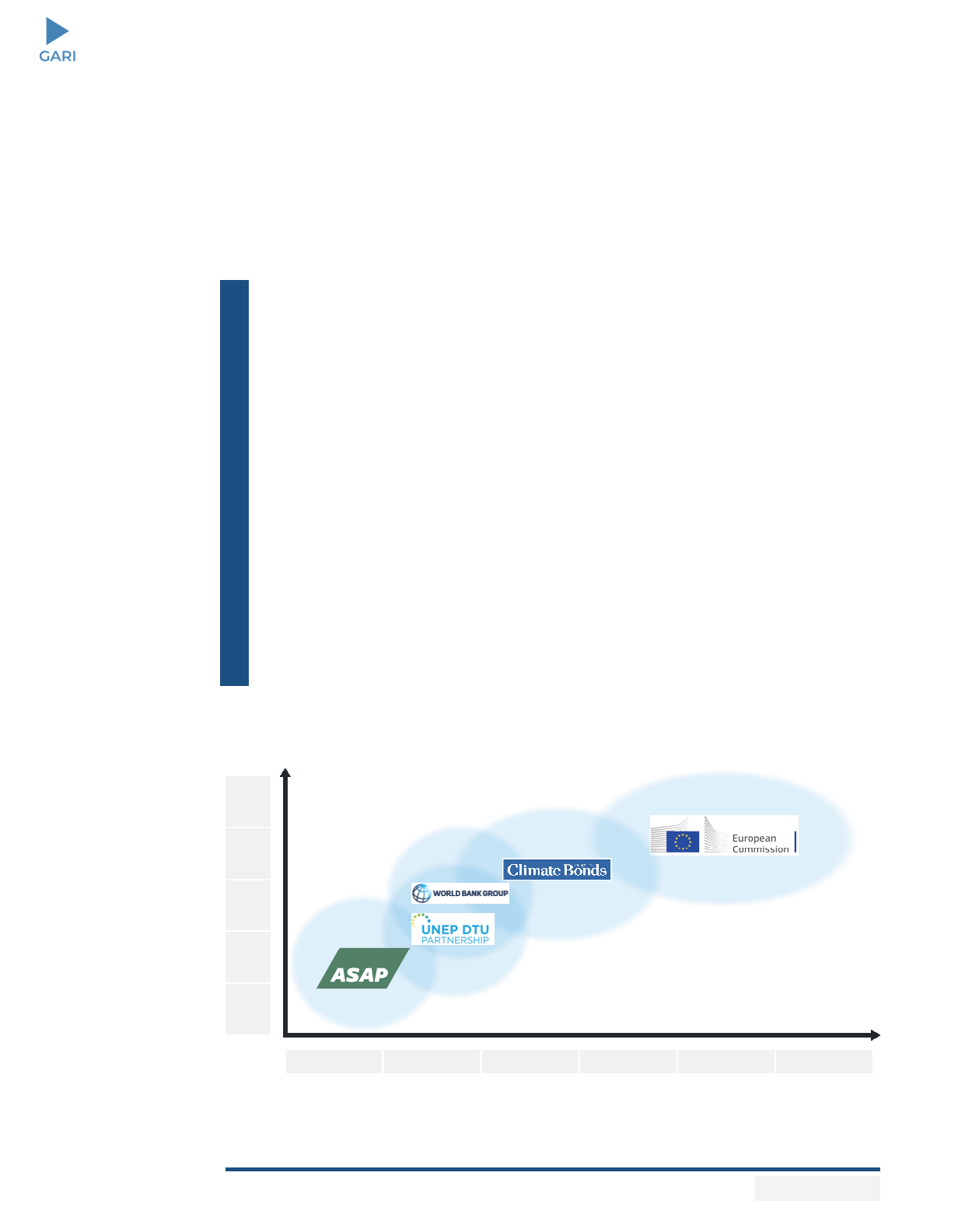
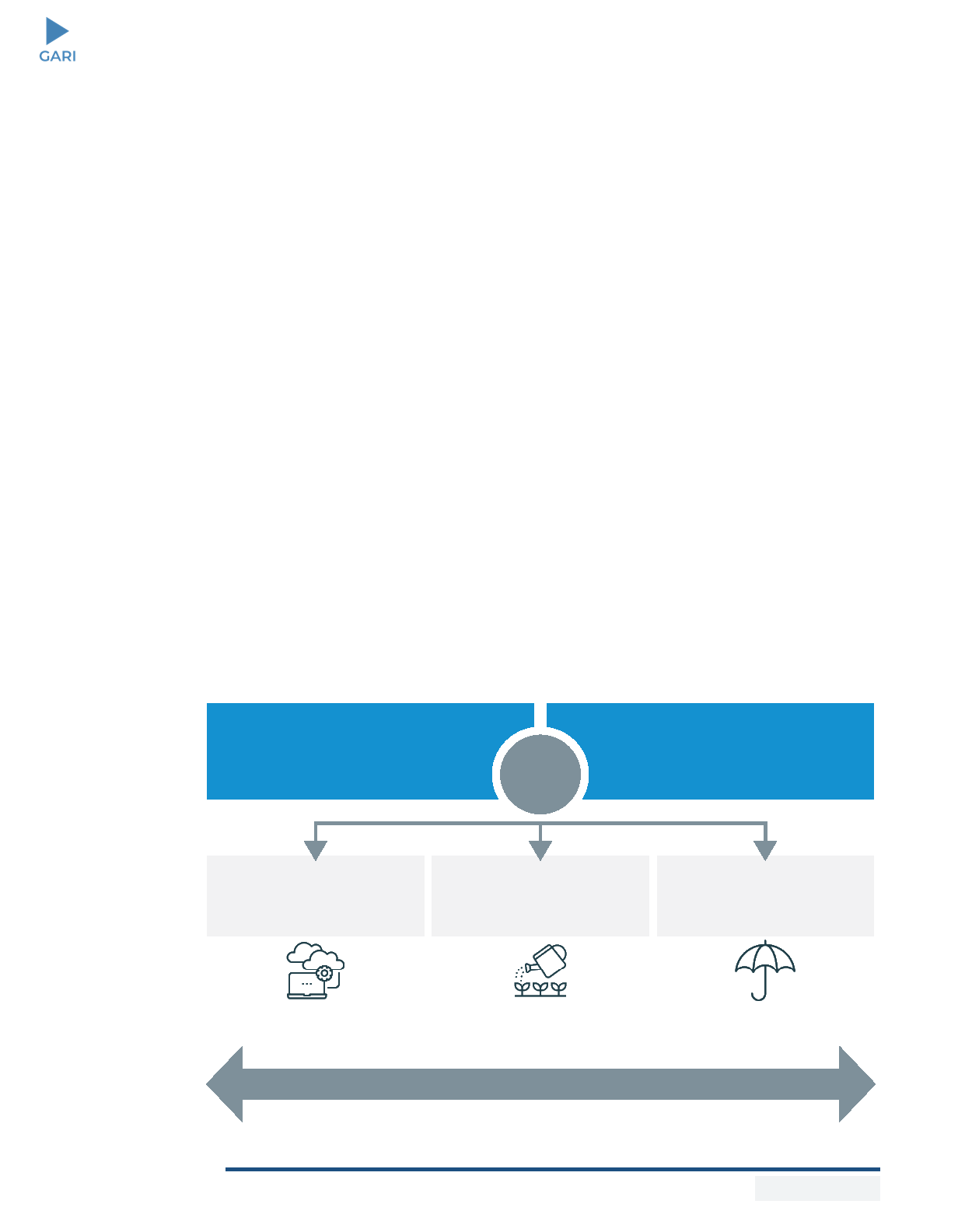




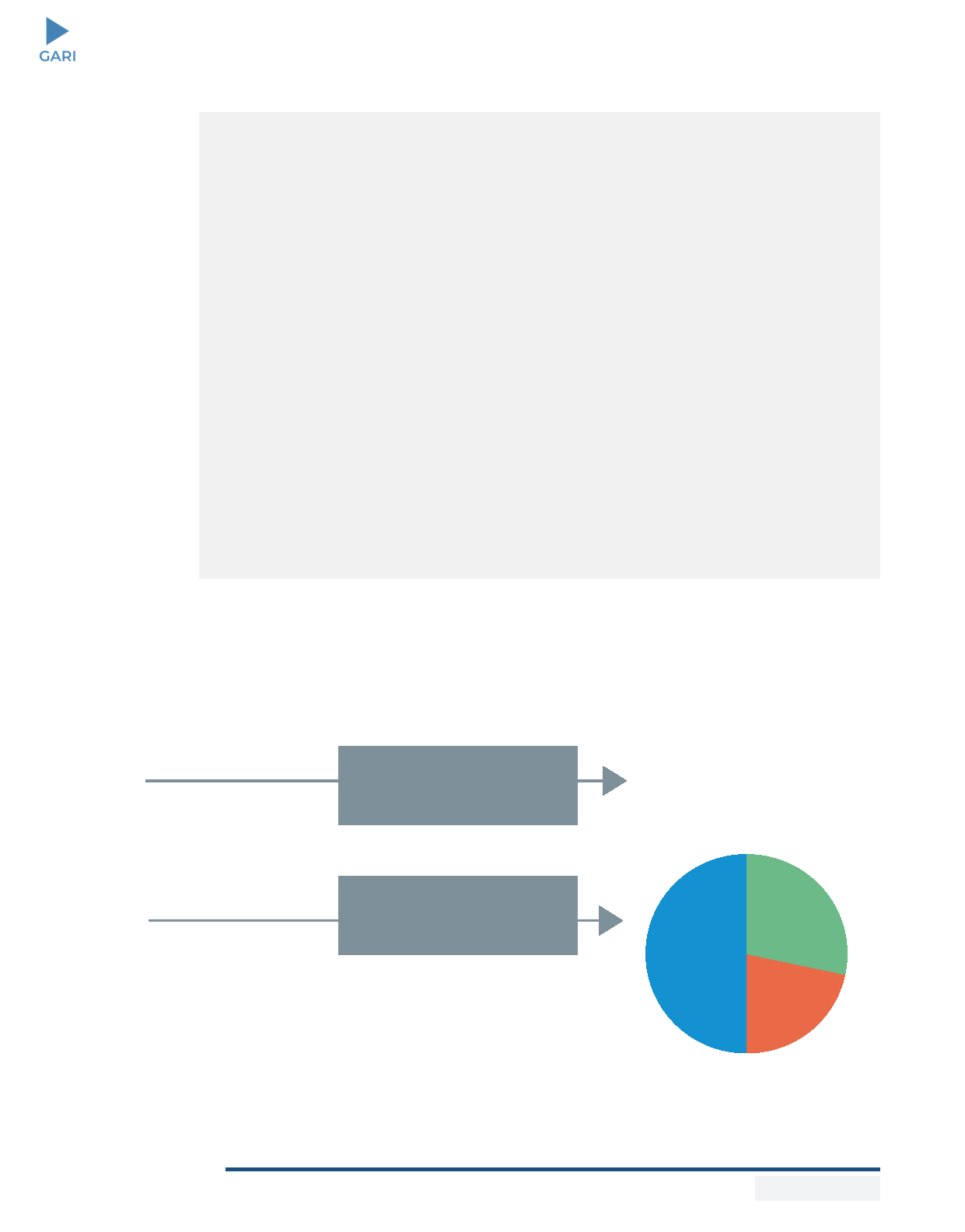
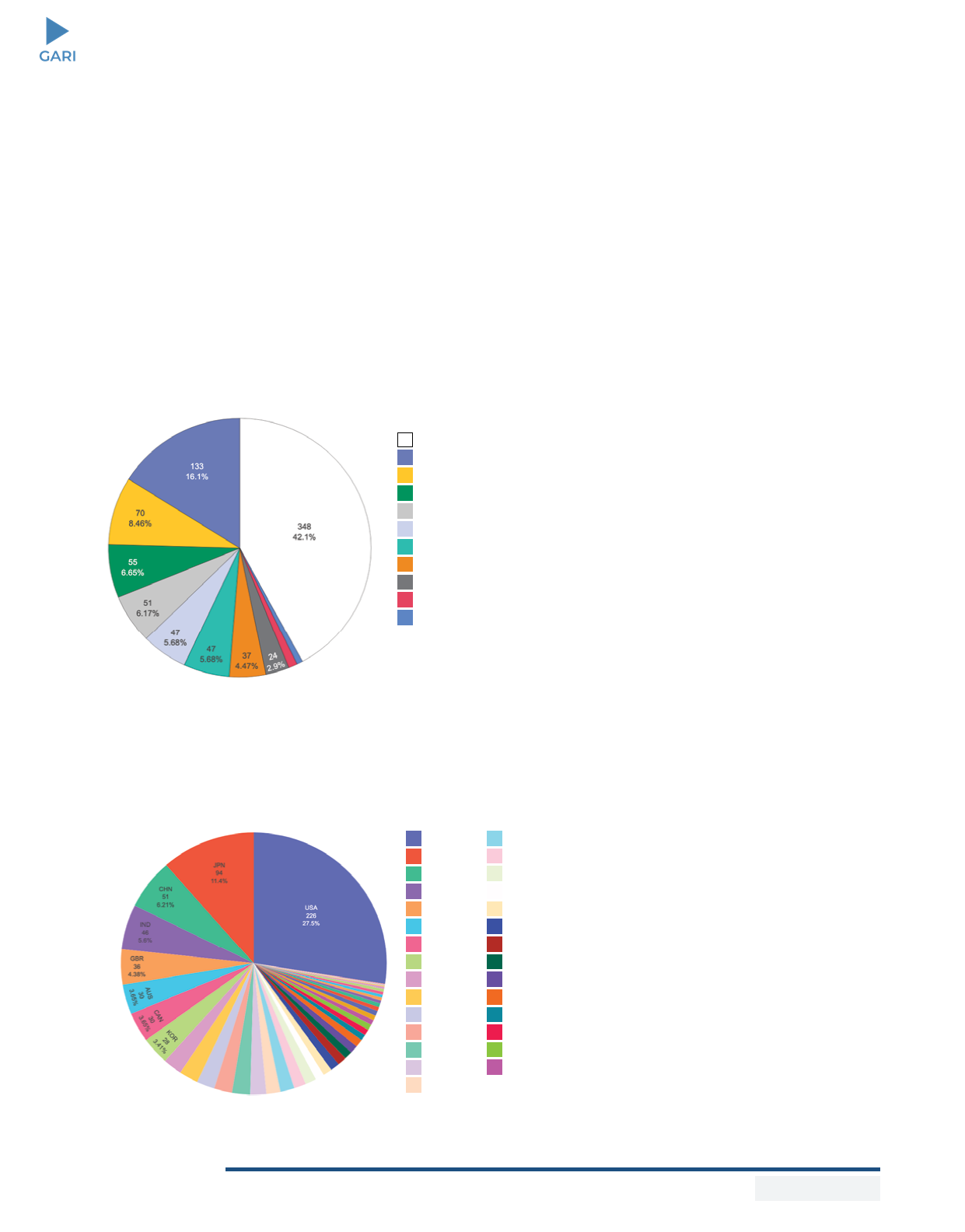

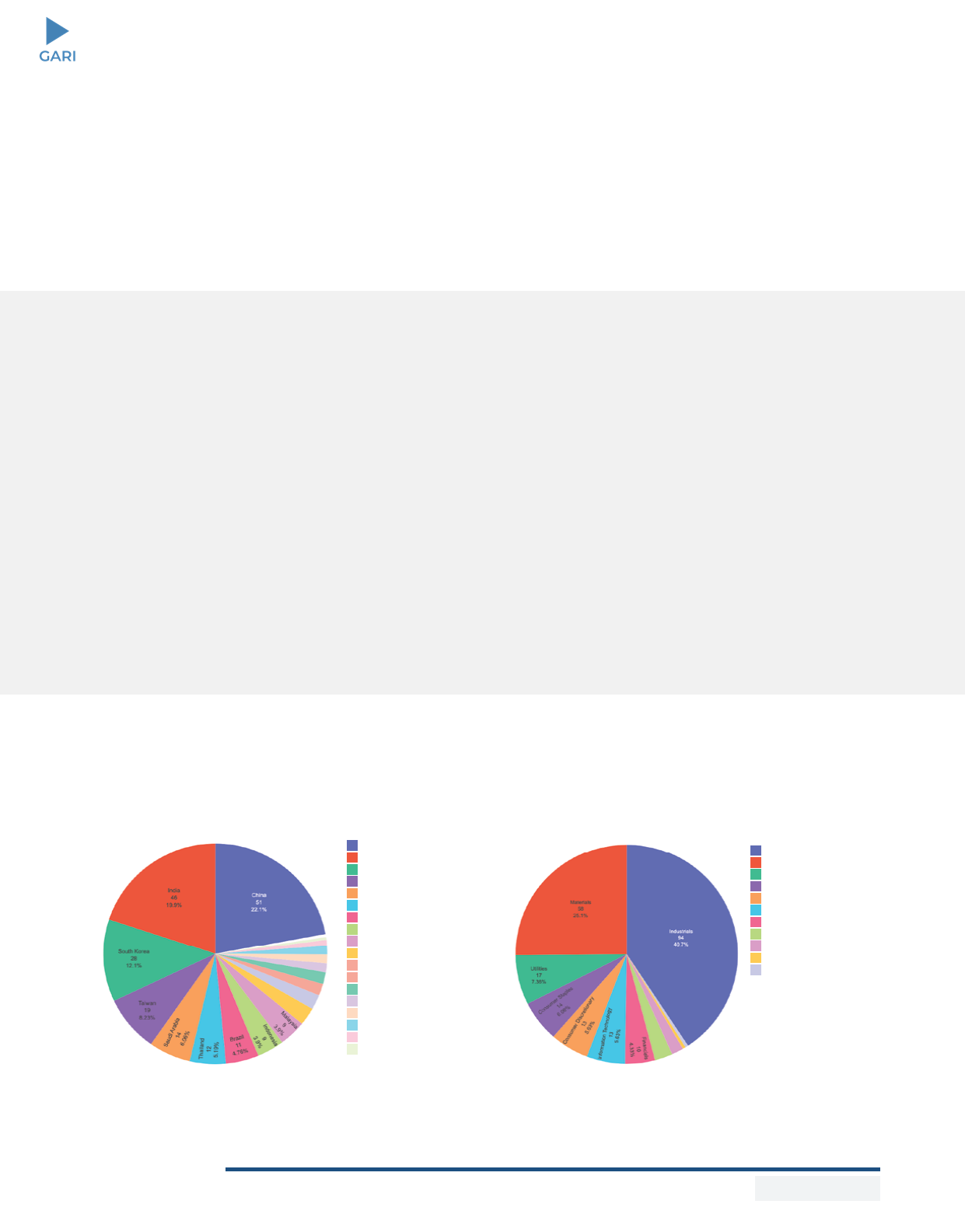





The Unavoidable
Opportunity:
Lead Author: Lori Collins
Contributors: Umar Ashfaq, Turbold Baatarchuluu, Erica Downing, Tara Guelig, Jay Koh, Linda-Eling Lee
March 2024
A discussion paper by:
Global Adaptaon &
Resilience Investment
Working Group
Data and analysis by:
In partnership with:
Investing in the Growing Market
for Climate Resilience Solutions

Global Adaptation &
Resilience Investment
Working Group
Table of Contents
Executive Summary 3
Adaptation Investment Thesis - Scope of Opportunity
5
Identifying Adaptation Solutions Companies
11
Approaches to Portfolio Construction for Thematic
Exposure
16
Conclusion
21
About
22
Disclaimer
25
I.
II.
III.
IV.
V.
VI.
Table of Figures & Tables
Uses of Climate Finance 2021/2022
5Figure 1:
Billion Dollar Disasters
6Figure 2:
Examples of Adaptation Solutions by Sectors
and Hazards
8Figure 3:
Taxonomies for Resilience Investment
11Figure 4:
Description of an Adaptation Solution Company
12Figure 5:
First Cut of Resilience Company Universe
17Figure 6:
Resilience Companies by Sector - First Cut
18Figure 7:
Resilience Companies by Country
18Figure 8:
Resilience Emerging Market Companies by Nation
19Figure 9:
Resilience Emerging Markets Companies by Sector
19Figure 10:
Illustrative List of Current Climate Hazards,
Risks and Impacts
7Table 1:
References
23VII.
The Unavoidable Opportunity: Investing in the Growing Market for Climate Resilience Solutions
Page 2 of 25
March 2024

I. Executive Summary
The growing urgency of climate change
has generated two related investment
opportunities: the need to reduce the
causes of climate change through
investments in decarbonization
and the need to manage mounting
physical effects through investments
in climate resilience. Technologies
and solutions that can reduce the risks
and impacts of climate change are
growing in demand, generating related
and attractive growth opportunities for
investors. Governments are planning
ood defenses, companies are
hardening their physical infrastructure
and supply chains, and households are
protecting themselves against extreme
heat.
Climate resilience investments are
fundamentally attractive for several
reasons. There is now greater certainty
around the near-term trajectory of
climate change and the demand
drivers for climate resilience, which are
uncorrelated and independent from
other market forces. Climate resilience
measures can support investible
opportunities that leverage the power
of nature-based solutions and enhance
biodiversity. Because physical climate
impacts will disproportionately affect
the poorest and most vulnerable
populations and nations, climate
resilience solutions can also advance
equity and environmental justice
Climate resilience and adaptation is an attractive growth investment theme
that is investible today, including through publicly listed companies.
considerations. Yet climate resilience
is substantially underinvested and, we
believe, not priced into markets, leaving
open greater opportunity for investors.
Climate resilience investments are
not well understood by investors,
and therefore practical frameworks
are needed to inform investment
decisions. Few companies today
self-identify as “climate resilience” or
“adaptation” companies.
*
However,
established, market-driven approaches
can be used to identify companies
that provide climate resilience and
adaptation solutions. Many taxonomies
exist to identify climate resilience
companies, yet these models may be
limited to specic regions, focus only
on emerging technologies, or tend
towards needs assessments rather
than solutions. In order to provide a
comprehensive approach, considering
all regions and companies, a new model
has been developed and peer-reviewed
for identifying climate resilience
and adaptation companies, and is
introduced in this paper as the “CRISP
Framework.”
Publicly traded companies offer
an opportunity to invest at scale in
climate resilience and adaptation.
A new market analysis that applies
the climate resilience framework to
publicly accessible data has identied a
Global Adaptation &
Resilience Investment
Working Group
The Unavoidable Opportunity: Investing in the Growing Market for Climate Resilience Solutions
Page 3 of 25
March 2024
*
Adaptation and resilience are two related parts of a continuum of strategies to address the effects of climate
change: Adaptation refers to systemic adjustments to climate change, while climate resilience refers to the ability to
recover from risks and impacts of climate change. These terms will be considered together in this paper.

Spotlight on Emerging Markets – Executive Summary
Emerging markets across the globe represent $6.5 trillion
1
in total market
capitalization and are expected to outpace the growth of developed markets
by 2030.
2
Climate change, however, is one of the top risks to these economic
projections.
3
As a result, demand for adaptation solutions in emerging markets
is ripe for growth to address climate hazards on the horizon and already occur-
ring at record pace. This paper includes a new analysis mapping companies
that provide adaptation solutions listed in 47 markets worldwide, including 24
emerging markets (see Section IV). Of the 827 companies identied globally,
231 were listed in emerging and developing countries, demonstrating that a
sizeable share of the potential investment opportunity for climate resilience
solutions is based in the Global South.
universe of over 800 public companies
that offer climate resilience and
adaptation solutions. This universe of
solutions offers broad access to the
adaptation investment growth theme
for additional capital to support a
variety of public markets investment
approaches. Investors in private
companies have already demonstrated
opportunities for investments in climate
resilience and adaptation solutions, and
the market is ready to move beyond
private equity to larger, more substantial
investments in publicly traded
companies.
This paper presents an initial toolkit for
investors considering climate resilience
as a thematic area, particularly in public
markets. It describes:
• Why climate resilience solutions
offer a compelling investment
thesis from a returns perspective
• What is meant by climate
resilience solutions: the products,
technologies, and services that are
in growing demand as households,
companies, and governments
seek to protect the economy and
communities from escalating
physical climate risk
• A proposed framework to dene
which companies are “in the
business of resilience”
• Methods to locate these companies
within the investable universe of
publicly listed companies
• How investors can design
investment products to provide their
clients with exposure to the theme
Global Adaptation &
Resilience Investment
Working Group
The Unavoidable Opportunity: Investing in the Growing Market for Climate Resilience Solutions
Page 4 of 25
March 2024

II. Adaptation Investment
Thesis – Scope of Opportunity
Climate change is creating a compelling investment opportunity in the
category of climate resilience.
Climate change is a humanitarian
tragedy and planetwide emergency
with devastating impacts and human
costs. The direct and ensuing effects
of climate change are bearing down on
all geographies, all segments of society
and all economies. Last year, the World
Meteorological Organization (WMO)
reported that almost 12,000 extreme
weather, climate, and water-related
events over the past 50 years have
caused over $4.3 trillion in losses.
4
In
2022, natural disasters caused global
economic losses of $313 billion, of
which less than half was insured.
5
In
the U.S. alone, climate and weather
disasters have caused roughly $120
billion in damages per year since 2017.
6
The urgency for action has accelerated
with United Nations Intergovernmental
Panel on Climate Change (IPCC)
warning in 2023 is that the world is
“risking severe damages, costs, and
upheaval.”
7
Solutions to climate
change are essential.
By now investors are familiar with
decarbonization as a growth investment
thesis. Billions of dollars of capital have
shifted into renewable energy, electric
vehicles, energy storage, and low
carbon solutions for everything from
agriculture to infrastructure as investors
have recognized the opportunity for
returns created by the growing urgency
to address the causes of climate
change.
Resilience to the effects of climate
change has similar drivers, arguably
even more fundamental and more
certain ones. The need to climate-
proof economies and societies
will grow inexorably in the coming
decade regardless of the pace of
decarbonization. Yet to date, nancing
for adaptation has been framed around
the cost, primarily to governments, of
hardening economies and communities
to physical climate risk. Because they
are viewed only as costs, investments
in adaptation have been miniscule
compared to those in decarbonization.
Climate Policy Initiative (CPI) estimated
$1.3 trillion annual average investments
into climate-related equities, bonds,
projects, and assets in 2021/2022,
almost double the previous period.
8
Although less than 5% of this ow - $63
billion - was for adaptation, investment
Global Adaptation &
Resilience Investment
Working Group
Figure 1: Uses of Climate Finance 2021/2022
Source: Climate Policy Initiative, Global Landscape of Climate Finance 2023, p21
0
200
400
600
800
1000
1200
Private
Public
Dual BenefitsAdaptationMitigation
614
536
62
42
USD
Billions
1.5 9
The Unavoidable Opportunity: Investing in the Growing Market for Climate Resilience Solutions
Page 5 of 25
March 2024

grew 29% from $49 billion in the prior
period. That said, nearly all adaptation
was funded by public actors (98%)
according to CPI,
9
which leaves just
$1.3 billion in identied and tracked
private sector investment in adaptation
2021/2022 across the globe. The
private sector drives almost half of
nancing for renewable energy, but has
not yet systematically focused on the
escalating demand for adaptation
10
as
shown in Figure 1 above.
Figure 2: Billion Dollar Disasters
United States Billion-Dollar Disaster Events 1980-2023 (CPI-Adjusted)
Citation: NOAA National Centers for Environmental Information (NCEI) U.S. Billion-Dollar Weather and Climate Disasters (2023). https://www.ncei.noaa.gov/access/billions/, DOI:
10.25921/stkw-7w73
Drought Count
Flooding Count
Freeze Count
Severe Storm
Count
Tropical Cyclone
Count
Wildre Count
Winter Storm
Count
Combined
Disaster Cost
Costs 95% CI
5-Year Avg
Costs
Climate change is generating increasing and
more certain risks and impacts.
1
There is greater certainty around the
near-term trajectory of climate change
and the demand drivers for climate
resilience. Even with solid progress
on decarbonization, the scientic
community’s latest IPCC v.6 report
projects 1.5C degrees of warming in
almost all scenarios within the next 10
years, which will highly likely increase
impacts on society and the global
economy. Demonstrating just how
evident these impacts already are, the
U.S. suffered billion-dollar climate
catastrophes 28 times in 2023, the
highest number of disasters ever in
a calendar year, as shown in Figure
2 below.
11
The need for adaptation
nance in developing countries is even
more cogent; requirements are 10 to 18
times as large as international public
nance ows.
12
In our view, the climate resilience growth investment opportunity is
based on three overarching drivers:
Investment
Opportunities in Climate
Resilience Companies
Demand for Climate
Resilience Solutions
Increasing Climate
Risks & Impacts
Global Adaptation &
Resilience Investment
Working Group
The Unavoidable Opportunity: Investing in the Growing Market for Climate Resilience Solutions
Page 6 of 25
March 2024

Climate hazards will increase risks
and impacts across the economy,
as indicated in Table 1. Expected
climate risks and impacts are well-
documented by the IPCC and other
global climate organizations. Many of
these impacts are already evident, with
future damages likely to be enormous
given the lock-in of greenhouse gas
emissions over previous decades. As a
result, the costs of climate adaptation
will grow only more expensive with the
passage of time. Climate change may
represent more certainty of risk and
impact over the next ten years than
potential economic effects of interest
rates, ination, articial intelligence,
consumer preferences, or other
factors that can affect investment
performance.
Climate risks and impacts are generating increasing demand for
technologies and solutions that build resilience and adaptation.
2
As climate risks and impacts increase,
demand for new technologies and
adaptations solutions is accelerating.
Financial regulators and central banks
have pointed to the physical impacts
of climate change as a material and
potentially systemic risk for nancial
markets. In the insurance sector,
climate change is now the top risk -
higher than cybersecurity - according
to the 12th Annual Survey of Emerging
Risks.
16
Institutional investors,
insurance companies, pension funds
and other asset managers are keen
to understand these climate risks as
well as the opportunities to improve
investment performance.
Companies understand that climate risk
matters and are actively considering
it in their strategies. A group of over
200 of the world’s largest corporations
reported $1 trillion in estimated
nancial risk from climate change.
17
Accordingly, companies in most
sectors, including 69% of biotech,
healthcare, and pharma companies,
83% of retailers, and 88% of nancial
services rms, are actively integrating
climate change impacts into their
respective business strategies.
18
Efforts to deepen understanding
of potential risks are supported by
emerging climate data and analytics
companies, articial intelligence
and many other tools such as earth
observation, remote sensing, and
satellites. Increasingly robust data
gives companies the tools to translate
these risks into opportunity costs to
help justify investments in adaptive
technologies.
All sectors from agriculture, water,
transportation, energy, nancial
services, and healthcare must
adapt to new climate conditions
while decarbonizing in tandem.
Agricultural analytics, water efciency
solutions, supply chain analytics, grid
reliability, advanced insurance, and
Global Adaptation &
Resilience Investment
Working Group
Table 1: Illustrative List of Current Climate
Hazards, Risks and Impacts
Key Climate
Hazards
Extreme
Temperatures
Drought
Extreme
Storms
Sea Level
Rise
Risks Impacts
Heat stress, cold waves, wild-
fires, reduced arable land
Inland and coastal flooding,
power outages, saline intru-
sion
Flooding, saline intrusion,
coastal erosion
Crop loss, asthma, spread
of pests, vector-borne
disease
Property loss, business
loss and interruption, infra-
structure damage, crop and
marine life loss, disease
Infrastructure loss, property
loss
13
14 15
The Unavoidable Opportunity: Investing in the Growing Market for Climate Resilience Solutions
Page 7 of 25
March 2024

agile healthcare diagnostics all will
be increasingly needed as a result
of rapidly changing environmental
conditions. Representative solutions to
climate impacts are shown in Figure 3
as illustrative examples.
Recognition and experience of climate
risks and impacts is already leading to
increased spending to address specic
climate hazards in the private sector.
Figure 3: Examples of Adaptation Solutions by Sectors and Hazards
(Illustrative, not exhaustive list)
Climate Related
Impact Drivers
Extreme
Heat
Drought
Extreme
Storms
Sea Level
Rise
Sector
Examples of Adaptation Solutions
Climate Adaptation Intelligence Climate Adaptation Products & Services
Agriculture
Real Estate
Water Supply &
Management
Information
Technology
Infrastructure &
Transportation
Energy
Health
Financial
Services
• Climate monitoring and forecasting
• Temperature regulation technologies for livestock
• Remote sensing-based drought monitoring tool
• Crop data and analytics platform with mapping interface
• Satellite imagery for monitoring and impact assess-
ment
• Sea-level processing software
• Water monitoring and modelling (e.g. water resource
mapping)
• Hydrological forecasting system
• Climate risk analytics
• Geospatial solutions
• Intelligent transportation systems to monitor road
conditions, address hazards in real time, moving traffic
away from areas experiencing a natural disaster, point
first responders to identify priority intervention areas
• Artificial intelligence for grid management
• Artificial intelligence for outage management
• Community-level communication systems
• Disease surveillance systems for outbreak detection
• Remote diagnostics
• Rapid diagnostic tests
• Data analytics to better assess borrower repayment
risk
• Biometrics
• Drought tolerant crops
• Cold chain storage
• Irrigation technologies using high-efficiency systems
• Flood mitigation technologies
• Efficient cooling technologies
• Green roofs
• Water storage technologies
• Water preservation technologies; e.g., smart water
meters
• Irrigation technologies
• Early warning systems for extreme events
• Early response systems
• Stormwater management - drainage and conveyance
• Extreme heat/cold resistant paving material
• Wetlands restoration
• Grid hardening technologies
• Weatherization of renewable assets
• Distributed energy systems/community grids
• Vaccines for new diseases
• Drug treatments for new diseases
• Air purification systems
• Climate parametric insurance
• Digital payment systems
• Blockchain
For example, Pacic Gas and Electric
(PG&E), the 10th largest utility in the
United States, increased its wildre
mitigation plan over $1 billion from
the actual cost in 2021 to $5.96 billion
planned for the year 2022.
19
Recent
regulatory actions in the U.S., such as
the Ination Reduction Act, are further
incentivizing investors to allocate
capital toward solutions that combat
climate-related risks.
Global Adaptation &
Resilience Investment
Working Group
Mounting demand for climate resilience technologies and solutions
creates a growth investment opportunity in existing and new
companies that produce those products and services.
3
Companies offering solutions for
climate resilience will benet from
increasing demand to address the
growing risks and impacts from
climate change, with BlackRock already
reporting initial indicators of increasing
demand for such products.
20
Given
this growing demand, the market may
be under-valuing companies that meet
the need for climate solutions, a factor
that BlackRock considers a driver of
investment opportunity.
21
Many of the
technologies and solutions required
to address climate impacts already
exist, as shown in Figure 3, and may be
available in the market today, although
The Unavoidable Opportunity: Investing in the Growing Market for Climate Resilience Solutions
Page 8 of 25
March 2024

Global Adaptation &
Resilience Investment
Working Group
not always identied as “adaptation
solutions.”
In addition to market opportunity,
climate resilience investments can
enhance the returns of decarbonization
investments. For example, hydropower
generation will need to incorporate new
data and analytics about increasing
drought conditions occurring as a
result of climate change. Failure
to incorporate projected drought
has already threatened renewable
hydropower generation in California.
22
Smart grid upgrades to support
intermittent renewable energy will
also have to address new spikes in
demand created by climate-enhanced
heat waves.
23
Climate modelling to
simulate increased wildre risk due to
hotter, drier conditions will be critical
to reducing the risk of wildres caused
by transmission and distribution
powerlines.
24
Supply chains will have to
both reduce their carbon intensity and
address potential disruptions caused by
more frequent and severe hurricanes,
storms, and wildres.
As investors scale capital into
decarbonization, investing in climate
resilience technologies and solutions
can safeguard and support the success
of those investments. Incorporating
climate change assumptions around
changes in wind patterns, cloud
cover, and water levels into renewable
energy projects can future-proof them
against increasing impacts of climate
change. Including sea level rise and
ooding analyses into the design of
energy efcient buildings can make
them better low carbon investments.
Developing climate smart agriculture
that is both less carbon intensive and
more resilient to drought and extreme
weather can generate both greater
food security and better long term
investment performance.
Climate resilience investments can
also help enable further investments
in biodiversity and nature-based
solutions. For example, investments
in climate risk data and analytics can
inform the design projects that support
biodiversity, agriculture and human
health. Geospatial data and imagery
can help to monitor and implement
nature-based solutions. Accurate
forecasts of climate-enhanced ooding,
for example, can help design ood
defenses like mangroves and wetlands
to supplement seawalls and levees.
Natural climate solutions can effectively
and efciently achieve adaptation
goals as well as support mitigation,
biodiversity, and more equitable
community development. Nature
protection and restoration, by far the
largest forms of carbon sequestration,
must be resilient to wildres, droughts,
heatwaves, and longer-term warming to
preserve their mitigation benets.
Finally, climate resilience solutions
can address the most impacted and
vulnerable populations and help
address equity, justice, and gender
considerations. Disadvantaged
populations in both developed and
developing countries have historically
faced higher vulnerability and suffered
the greatest impact from environmental
hazards, and increasingly from
the physical risks and impacts of
climate change. Women and girls
are particularly vulnerable to water
scarcity, agricultural stress, and natural
disasters, all of which are increasing
due to climate change.
25
Even if these
populations do not have the resources
to be direct buyers of these solutions,
they can benet from distribution
and use in their regions. Intelligence
technologies such as satellite imagery,
digital mapping, catastrophe risk
modeling and weather analytics can
provide critical information as systemic
solutions to safeguard and protect
disadvantaged populations in all areas
of the world, e.g. adaptation solutions
The Unavoidable Opportunity: Investing in the Growing Market for Climate Resilience Solutions
Page 9 of 25
March 2024

Spotlight on Emerging Markets – Scope of Opportunity
While no standard denition of emerging markets exists, leading institutional inves-
tors using the MSCI Emerging Markets Index as a benchmark can measure market
exposures for 24 countries in this universe including China, India, and Brazil with as
many as 3,400 issuers in the investment opportunity set.
27
In aggregate, emerging
markets represent 46% of the world’s purchasing power and 34% of global nominal
GDP.
28
Relative to other developing countries,
29
these markets have more mature
capital markets along with supportive government and regulatory structures.
The investment risks pertaining to emerging markets are generally elevated, howev-
er, and not conned to adaptation and resilience companies. Emerging markets un-
derperformed developed markets in the decade between 2011 and 2023, largely due
to lower corporate earnings growth.
30
Both liquidity and access to capital are lower
for emerging markets compared to developed markets.
31
Overall, assets in emerg-
ing markets are perceived as riskier than their counterparts in developed markets, as
quantied in the volatility of returns when comparing the two.
32
Climate change may pose an even greater risk to emerging markets, which tend
to be in the path of climate destruction with lower budgets for safeguards against
these risks. In fact, climate hazards are already affecting these regions - driving
demand for solutions. Investors can lean into this demand, as well as the rising
incomes and economic growth in these regions, while also seeking investments
with decarbonization co-benets. Investors and local communities alike can benet
by driving local resilience, creating markets to sell into, and integrating investments
with decarbonization investments such as distributed energy.
Global Adaptation &
Resilience Investment
Working Group
that support water access and food
security in the face of increasing
drought and food production stress
will also be important to supporting the
most vulnerable across the world.
Some pioneering investors have already
seen these growth opportunities
and put adaptation at the heart of
their investment strategies. The rst
dedicated adaptation and climate
resilience private investment fund,
Lightsmith Climate Resilience Partners
(also known as CRAFT, the Climate
Resilience and Adaptation Finance
and Technology-transfer facility),
reached rst close in 2019, and has
been actively making growth equity
investments in private companies
that support climate resilience. Large
nancial institutions have identied
adaptation strategies within their
dedicated Climate or Impact funds,
which together exceed a billion
dollars.
26
However, at present few
easily investable public market
products exist by which investors can
gain targeted and systematic exposure
to companies that produce solutions for
adaptation and climate resilience.
The Unavoidable Opportunity: Investing in the Growing Market for Climate Resilience Solutions
Page 10 of 25
March 2024

III. Identifying Adaptation
Solutions Companies
Climate resilience investments can be identied by investors.
Since not all companies self-identify
their products and services as
“climate resilience” or “adaptation”
technologies and solutions, there
is need for greater clarity as to the
investible universe for investors to
uncover these growth opportunities. In
order to support investors in identifying
adaptation solutions companies,
GARI has developed a framework that
incorporates existing methodologies
and aligns with ongoing developments
to identify adaptation opportunities
with a range of investment strategies,
including application to listed equities.
Goals of the Framework for
Identication
GARI’s 2024 Climate Resilience
Investments in Solutions Principles
(CRISP) framework is intended to offer
a structured approach for transparently
determining whether a company has
growth potential as an “adaptation play”
based on the technologies, products
and services offered across all asset
classes, sectors, and geographies.
The CRISP framework builds on
existing denitions and approaches
to identifying adaptation companies,
with consistency and alignment with
the EU Sustainable Finance Taxonomy,
Climate Bonds Taxonomy, and the 2020
ASAP Adaptation Solutions Taxonomy.
However, existing taxonomies such
as these, and those proposed by UN
Environment Programme Technology
Needs Assessment (TNA),
33
World
Bank Group,
34
and many others
35
may
be regionally targeted, focused on
Global Adaptation &
Resilience Investment
Working Group
Figure 4: Taxonomies for Resilience Investment
Company Size
Geography
Seed
Stage
Venture
Capital
Project
Finance
Private
Equity
Publicly
Traded
Active
Least Developed
Countries
Developing
Countries
Emerging Markets
Developed Countries Focused Markets All Markets
The CRISP Framework seeks to encompass current
sustainable finance taxonomies to provide a holistic and
inclusive framework for companies in all regions and
growth stages, specifically focused on resilience and
adaptation solutions.
The Unavoidable Opportunity: Investing in the Growing Market for Climate Resilience Solutions
Page 11 of 25
March 2024

needs assessment versus solutions,
or limited to identifying emerging
technologies (see Figure 4). The
CRISP framework is proposed as a
comprehensive approach to address
the current gaps and limitations.
The goal of the framework is to
consistently guide investments
into adaptation and resilience at
various stages and to facilitate the
identication, evaluation, investment,
reporting, and engagement with
companies. Adaptation companies
are part of large and emerging theme,
a hallmark of growth investing.
Facilitating adaptation and resilience as
a growth theme for equity investments
is a key desired outcome of the
identication framework.
Scope of the Framework
The scope of this framework is limited
to companies that provide adaptation
and resilience products and services
to third parties rather than businesses
that are taking measures to make their
operations more internally resilient,
which has become a mainstream
element of risk management.
Principles of the 2024 CRISP
Framework
The 2024 CRISP framework aims to
create an inclusive, exible approach to
identifying potential climate resilience
companies that recognizes both
the development of adaptation and
climate resilience as an emerging
investment theme, and that climate
change risk and impacts will continue
to evolve over time. It is intended
to be applied broadly and does not
prescribe a list of companies, sectors,
requirements nor categorically
exclude types of companies, but
Addressing systemic barriers to adaptation,
including by removing information,
technological, capacity and/or financial
barriers to adaptation by others
AND
/OR
Directly reducing material physical climate
risks or their associated adverse impacts on
other people, nature, physical assets or
other economic activities
Enable to prepare and prevent physical
climate risks by increasing the ability of
people, nature, physical assets or businesses
to understand climate-related risks and
manage them with foresight
Enable to respond to physical climate risks
by increasing the ability of people, nature,
physical assets or businesses to cope and
adjust to adverse conditions
Enable to recover from adverse physical
climate impacts by increasing the ability of
people, nature, physical assets or businesses
to mitigate the adverse impacts of climate
events and ‘build-forward-better’
Before During After
Examples of
Resilience
Solutions
Adaptation
Continuum
Climate information
services
Water-efficient irrigation system
in drought prone rain fed context
Climate parametric
insurance
Figure 5: Description of an Adaptation Solution Company
A Resilience Solutions Company is a company that has a signicant business offering of a technology, product, service and/or practice that
enables others to prepare, prevent, respond to and recover from climate shocks and stresses by:
Global Adaptation &
Resilience Investment
Working Group
The Unavoidable Opportunity: Investing in the Growing Market for Climate Resilience Solutions
Page 12 of 25
March 2024

instead provides illustrative and non-
exhaustive examples. The principles
point towards assessment of the
growth potential of a company, line
of business or product market. Given
that the adaptation market is evolving
with new and unknown impacts, the
framework leaves room for solutions
and technologies yet to be envisioned
and developed and explicitly calls for
periodic reassessment and evaluation.
This framework is intended to be:
• A dynamic and exible tool,
evolving over time along with
existing and emerging international
sustainable nance frameworks.
• Complementary to existing
frameworks, standards, and
regulations with high-level
guidelines for how the framework
and principles can be applied in
different contexts.
• Inclusive, without prescriptive pre-
dened lists of solutions because
the range of technologies, products
and services are wide ranging and
fast evolving.
• Agnostic to growth stage, sector,
and geography of adaptation
solutions to allow for both new
innovative solutions and business
models as well as the uptake and
transferring of existing ones to new
contexts.
Identication Framework
Fundamentally, an adaptation solutions
company has a signicant business line
in a technology, product or service that
prevents or reduces the impacts before,
during or after a climate hazard. Figure
5 provides a more detailed description
of a climate adaptation solutions
company and the elements to consider
from the new 2024 CRISP framework.
Adaptation solutions are wide-ranging
across physical risks and impacts and
across multiple sectors and already
offered by many large, publicly traded
companies. Identifying opportunities by
sector requires understanding the range
of impacts, and solutions existing or in
development.
Considerations for Listed Equity
Investors
Investors in listed equities will have
special considerations when pursuing
adaptation as a growth theme for their
portfolios.
• Engagement – Many adaptation
companies can be identied
through analytical methods using
publicly available information
such as earnings calls, investor
presentations, sustainability reports,
and annual reports. However,
increased insights gained from
direct engagement with investees
can be important to understanding
the growth strategy for prospective
adaptation solutions including the
company’s view of market size,
competitive position, and unique
value proposition for realizing
growth potential. The depth of
assessment, information available
and degree of active engagement
all can factor into identifying
adaptation companies and help
them, their supply chains and their
customers see their role in this
market.
• Thresholds – For large companies
involved in a range of activities,
the threshold of revenue coming
from adaptation products or
services within a business is
key consideration. Investors
can consider both current and
potential future value of revenue
derived from the resilient product
or service business line based on
the broader corporate strategy
and growth potential. For example,
even if the current level of revenue
or percentage of assets under
Global Adaptation &
Resilience Investment
Working Group
The Unavoidable Opportunity: Investing in the Growing Market for Climate Resilience Solutions
Page 13 of 25
March 2024

management is minimal, this
might be offset by future plans,
competitive positioning, research
and development budgets. A
company’s patent portfolio may
also be used as leading indicator
of future growth potential. Where
further engagement is possible,
investors can incorporate deeper
assessments of market capacity,
competitive position, and unique
product/market t in making their
determination.
• Consideration of net carbon impact
of solutions – The framework
suggests that adaptation solutions
should be sensitive to minimizing
net carbon impacts. However,
the net impact may be difcult to
assess, and complete data may
not be available. Engagement with
investees at every stage of the
investment process from screening
and due diligence to investment and
monitoring will be helpful to this
determination.
Example 1
Technology Company, New York Stock Exchange
$122 billion publicly traded multinational conglomerate offering products and
services related to building and industrial automation, energy solutions, and
aerospace technologies. Adaptation solutions include air purication systems, air
quality monitoring devices, refrigerants, power grid resiliency, and Internet of Things
urban communication networks. We estimate 18% of the company’s 2022 revenue
is from adaptation and resilience products.
Example 2
Pharmaceuticals Company, New York Stock Exchange
$76.6 billion publicly traded multinational pharmaceutical and biotechnology
company. Adaptation solutions include medication and research and development
on new vaccines, drugs and treatments to prevent and combat the spread of known
and emerging diseases that warming temperatures and extreme weather events
may exacerbate. Also invests in respiratory health medication to mitigate the
impact of air pollution. The company does not delineate product-level revenues. We
estimate approximately 20% of its total 2022 revenue is from products that alleviate
or combat climate-induced diseases and conditions.
Example 3
Engineering Company, Tokyo Stock Exchange
$3.5 billion publicly traded global engineering and technology products company.
Business segments include manufacturing of semiconductors, automotive
parts, medical devices and environmental monitoring and measuring equipment.
Adaptation solutions include water and air quality measuring devices. An estimated
2% of the company’s 2022 revenue is from adaptation and resilience products.
Global Adaptation &
Resilience Investment
Working Group
The Unavoidable Opportunity: Investing in the Growing Market for Climate Resilience Solutions
Page 14 of 25
March 2024

Spotlight on Emerging Markets – Identifying Companies
The consideration set of emerging market companies may include both those
domiciled in emerging markets, and those domiciled in developed markets that
may be selling into emerging markets or have foreign subsidiaries based in
emerging markets to better serve local needs.
Starting with this broad universe of companies, investors can apply GARI’s 2024
CRISP framework to identify companies that offer relevant adaptation solutions,
and may loosen or tighten criteria to expand or focus the results. These criteria
may include thresholds for the amount of revenue from specic geographies,
especially for companies not domiciled but selling into emerging markets.
Adaptation solutions are driven by local context, especially in emerging mar-
kets. Investors need to understand geographical, climatic, and social specics
such as exposure to physical risks, infrastructure gaps, and population trends.
Priority sectors for adaptation in these markets may include agriculture, water,
resilient infrastructure, and health due to the higher economic dependence in
emerging markets on natural resource management. For example, solutions
may include irrigation technologies, water metering, and disease prevention
drugs. In addition to these sectors, intelligence, monitoring, digital nance, and
warning systems are all in demand.
Global Adaptation &
Resilience Investment
Working Group
The Unavoidable Opportunity: Investing in the Growing Market for Climate Resilience Solutions
Page 15 of 25
March 2024

IV. Approaches to Portfolio
Construction for Thematic
Exposure
Armed with an understanding of which sectors and technologies are most
relevant for the resilience solutions thesis, and a framework for identifying
which companies are in the business of resilience, how can investors
identify the specic companies in the investable universe? This section
describes the results of an analysis undertaken by the MSCI Sustainability
Institute.
36
It focuses on public markets, using over 9,000 constituents of the
MSCI ACWI (All Country World Index) IMI (Investible Markets Index)
37
as of
December 2021, as the starting universe of potential companies.
38
Pilot Analysis Methodology
The approach to developing a universe
of “adaptation solutions” companies
started with identifying climate hazards
and impacts, and then identifying
the current solutions available based
on various adaptation and resilience
taxonomies and frameworks.
39
Companies domiciled across 47
countries, including all major stock
exchanges were considered in the
analysis. An understanding of existing
products and services was imperative
to ultimately identify their providers.
Various methods were tested to
determine the methodology best suited
for this exploratory exercise, including
the use of natural language processing
(NLP) and articial intelligence (AI).
Ultimately, the method used employed a
Large Language Model (LLM) to identify
companies that offer products and
services related to climate adaptation
or resilience. An LLM’s ability to
contextually understand text was an
advantage over prescriptive approaches
that use key words or phrase searching.
Company descriptions from annual
reports were used to determine if the
product offering may be classied as
an adaptation and resilience solution.
The methodology employed the LLM
to classify the companies based on
a set of questions to determine if the
company’s offering was an adaptation
solution. Preliminary analysis was
run on smaller sets of companies,
with manual validation determining
the quality of answers. Correct
classications were identied, and fed
to the LLM to be used as prototype
responses.
The analysis did not involve any direct
interaction with the companies in
the analytical set but required high
levels of manual validation with sector
analysts. The process was an iterative,
discovery-based approach to rene the
methodology, in order to reasonably
discern the nuance and complexity of
climate adaptation solutions offered by
publicly listed companies.
First Cut Identication of
Investible Universe
Initial analysis suggests that over 800
publicly traded companies exist that
could potentially serve as an investible
universe of companies for a variety of
public markets investment approaches
(see Figure 6). This represents about
11% of the overall MSCI ACWI index,
by number of issuers, after screening
out companies that did not pass the
Global Adaptation &
Resilience Investment
Working Group
The Unavoidable Opportunity: Investing in the Growing Market for Climate Resilience Solutions
Page 16 of 25
March 2024

Products and technologies can have more than one use case. The end-use may dene
the service as one that enables adaptation or, in extreme cases, contributes adversely to
climate change. As a hypothetical example for why investors should pay special attention
to multi-use products: pipes have end-uses for storm water drainage or irrigation – a
critical product to improve adaptation and resilience in key markets; pipes can also have
end-use for oil eld work.
Producers and sellers of such multi-use products are included the rst cut universe of
adaptation-enabling companies. The classication and ultimate inclusion of such multi-use
products in an adaptation-enabling portfolio would require the portfolio manager to better
understand the use cases or develop guidelines to guardrail investment decisions.
How investors treat such dual-use products has well-established precedents in responsible
and sustainable investing. For example, in the context of screening for weapons, investors
confront the challenge of dual-use items, whereby goods and services, such as aluminum
pipes and navigation technologies, can be used for both civilian and military applications.
Different investment institutions have different investment policies and statutory
obligations. Additional data that can indicate the degree of involvement in the target
activity, such as direct provision of goods and services or indirect contribution through the
value chain (e.g. distributor or retailer), may be applied such that each investor can best
match the level of involvement with the stringency of its policy.
40
Global Adaptation &
Resilience Investment
Working Group
Figure 6: First Cut of Resilience Company Universe
*ACWI IMI Index as of Dec 2021. This sample set already excludes companies agged under MSCI’s
EU Do No Signicant Harm (DNSH) criteria.
7,601*
47
ACWI IMI Index
Companies
Markets covering
large, mid and small
cap companies
99% of the global equity
investment opportunity set
23 Developed Markets (DM)
24 Emerging Markets (EM)
Small Cap
294
50%
Large Cap
127
21.6%
Mid Cap
167
28.4%
~827
A&R Companies
Multi-Use Products in the Context of Adaptation & Resilience
The Unavoidable Opportunity: Investing in the Growing Market for Climate Resilience Solutions
Page 17 of 25
March 2024

JPN
USA
IND
CHN
AUS
GBR
KOR
CAN
TWN
FRA
SGP
DEU
SWE
SAU
HKG
THA
CHE
IDN
BRA
NOR
MYS
DNK
ESP
ISR
ZAF
NLD
AUT
ITA
MEX
Figure 8: Resilience Companies by Country
Distribution of Resilience Companies per Country
assessing the investment opportunity
set in listed equities. The initial universe
of adaptation companies identied, and
the process for classication, lays the
groundwork to identify companies that
provide exposure to climate resilience
solutions via both fundamental,
quantitative, and qualitative methods.
Further analysis indicates that
industrials and materials Global
Industrial Classication Standard
(GICS) sectors constituted
approximately 58% of the identied
set of companies, as shown in
Figure 7.
42
Compared to the sector
distribution of the MSCI ACWI
IMI Index, these two sectors are
over-represented in the rst-cut
adaptation universe (based on the
number of companies), driven by
the focus on infrastructure and
materials inputs for adaptation and
resilience products.
The analysis also indicated that
two-thirds of resilience companies
are domiciled in developed markets,
as shown in Figure 8. These
590 companies represent a little
over 11% of the total universe of
developed markets included in the
MSCI ACWI IMI Index.
Approaches to Portfolio
Construction
Taking this framework for
identifying adaptation companies,
investors can apply these insights
in a range of ways to their
investment strategies. However,
gaining exposure to the adaptation
theme in portfolio construction
is nuanced and does not apply
consistently to all strategies. This
section provides specic insights
and considerations pertaining to
opportunities and limitations for
a range of investment strategies
including concentrated thematic to
Materials
Industrials
Information Technology
Consumer Discretionary
Real Estate
Financials
Consumer Staples
Utilities
Energy
Communication Services
Health Care
Figure 7: Resilience Companies by Sector - First Cut
Resilience Companies by GICS Sector
Global Adaptation &
Resilience Investment
Working Group
European Union “Do No Signicant
Harm” lter, as determined by MSCI
ESG Research’s EU Taxonomy
methodology.
41
The data analysis is limited as rst cut
ndings, yet the demonstration case
provides a market-based approach to
The Unavoidable Opportunity: Investing in the Growing Market for Climate Resilience Solutions
Page 18 of 25
March 2024

companies are more likely to be driven
by assessment of the underlying
business models and outlook for
growth, rather than from current
revenues.
Systematic investing, driven purely
on quantitative signals, would be
difcult to implement at this stage
of development because insufcient
data and contingency of any
adaptations solutions on the market
context presents challenges to rules-
driven processes. Likewise, passive
investment strategies for resilience are
not yet in sight, due to these needs for
fundamental analysis, high engagement
and focused investments.
For all equity investors into adaptation
themes, seeking alpha while controlling
risk remains a critical consideration.
Hence, investors may lean towards
sector allocations that hew to standard
benchmarks, rather than a highly
skewed sector distribution.
Fixed income is outside the scope of
this paper, but we note that it is an
important opportunity for adaptation
investing as well. These investments
are more likely to lean into project
nance or corporate bonds, and may
benet from some of the existing
frameworks such as the Climate Bonds
Taxonomy
43
for identifying solutions
and considerations for portfolios.
Potential Areas of Expansion
This initial analysis is just that – a
starting point for consideration
by investors. Other data sources
for analysis could include investor
presentations, corporate websites,
earnings call transcripts, ESG
reports and other sustainability and
impact reports. Data from company
reports may range from total market
capitalization to revenue by product
line, geographies and research and
development budgets.
broad tilts; fundamental and systematic;
equities and xed income; public and
private markets.
For example, concentrated strategies
may be too limited for a specic
adaptation growth theme in public
markets. Listed equities are unlikely to
be “pure play” adaptation investments
at this stage due to the size of the
companies on major stock exchanges.
Therefore, attempts to identify pure
play adaptation companies would
dramatically narrow the opportunity
set for investment. Over time, large,
diversied companies may opt to
spin-out adaptation-specic business
units, similar to how some energy and
industrial companies have spun out
businesses targeting climate mitigation.
Broad tilt strategies may be better
suited to incorporate companies
with some adaptation business
opportunities. Here, assumptions on
the signicance and growth potential
of adaptation business lines, relative
to other lines of business, are crucial
to assessing the potential exposure of
the portfolio to the target adaptation
themes of interest and their nancial
impact. Investors can use their own
analysis to set thresholds for relevance
of the theme to potential impact on
stock price or corporate strategy. In
other words, each investor would need
to express a view on where to draw
the line for the level or percentage of
revenue or other metrics to qualify as
having exposure to the target theme of
interest.
Similar to other emerging growth areas,
fundamental analysis is important to
evaluating investments in this area.
Investors can determine where they
see growth opportunities, where
value is underappreciated and alpha
undiscovered in companies offering
adaptation solutions. High conviction
for investments in adaptation
Global Adaptation &
Resilience Investment
Working Group
The Unavoidable Opportunity: Investing in the Growing Market for Climate Resilience Solutions
Page 19 of 25
March 2024

Global Adaptation &
Resilience Investment
Working Group
The Unavoidable Opportunity: Investing in the Growing Market for Climate Resilience Solutions
Page 20 of 25
March 2024
Spotlight on Emerging Markets – Portfolio Construction
Equities in emerging markets have potential for tremendous scale, with their
share of the global equity market projected to eclipse developed countries in
the coming years.
44
Major investment houses such as Wellington, JPMorgan
Chase, and Nuveen feature both emerging markets funds and climate funds.
Impact investors such as Sarona and Lightsmith are on the forefront of invest-
ing in climate solutions specically in emerging markets. A growth investment
theme around adaptation and resilience in emerging markets represents a new
universe of investments that is already gaining traction.
Mapping of adaptation solutions by MSCI identied at least 231 emerging
market-domiciled publicly-traded companies offering adaptation solutions in
these markets – a number expected to grow as demand for solutions acceler-
ates. This group represents 9.5% of the total emerging market companies in the
MSCI ACWI IMI Index. Details of where the companies are based and a distribu-
tion of the sectors represented are provided in Figures 9 and 10.
adaptation technologies, competitive
positioning for adaptation solutions,
t within overall company strategy,
secular trends that are creating growth
opportunities and how these companies
are positioned to take advantage of
growing needs and demands.
Active portfolio managers interested
in opportunities with this investment
theme should bring insight into
their investment decisions where
possible with investee engagement
to deepen their understanding of
the potential market size for new
Materials
Industrials
Consumer Staples
Utilities
Information Technology
Consumer Discretionary
Energy
Financials
Real Estate
Communication Services
Health Care
Figure 10: Emerging Markets
Resilience Companies by Sector
Source: MSCI Sustainability Institute
India
China
Taiwan
South Korea
Thailand
Saudi Arabia
Indonesia
Brazil
Malaysia
South Africa
Philippines
Mexico
Kuwait
Turkey
United Arab Emeirates
Poland
Egypt
Chile
Qatar
Figure 9: Emerging Markets Resilience
Companies by Nation
Source: MSCI Sustainability Institute

V. Conclusion
Climate resilience investments can be made at scale,
including in publicly traded companies.
Climate resilience is an attractive growth theme investment opportunity, with
investment prospects on par and in tandem with decarbonization. Investors
have a signicant opportunity to be on the forefront of investing in adaptation,
anticipating market needs, fueling demand for solutions and enabling
readiness for the future across markets, sectors and portfolios. Relevant and
attractive companies in this space can be identied through market-standard
analysis, identifying potential for investment at scale that fall within the
framework of the adaptation thesis. An explicit focus on “climate resilience” as
a growth investment theme capitalizes on rising demand for critical solutions
to current and future climate impacts that are certain to occur. Investments
in adaptation are growing, although remain nascent compared to the market
potential and overall global needs. Climate resilience investments are ready to
be made at scale in publicly traded companies.
This framework can help facilitate investment in adaptation solutions offered
by large companies, and offers a pathway to deploying large-scale allocations
at pension funds, actively managed funds, index funds or other public markets
investment strategies.
We invite you to access the new 2024 Climate Resilience Investments in
Solutions Principles (CRISP) on the GARI website and carefully consider
opportunities in this market. This is a roadmap for investors to identify
solutions and invest.
Global Adaptation &
Resilience Investment
Working Group
The Unavoidable Opportunity: Investing in the Growing Market for Climate Resilience Solutions
Page 21 of 25
March 2024

VI. About
Bezos Earth Fund is transforming the ght against climate change with the
largest ever philanthropic commitment to climate and nature protection. The
fund is investing $10 billion to protect nature and drive systems-level change,
creating a just transition to a low-carbon economy. By providing funding and
expertise, the fund partners with organizations to accelerate innovation, break
down barriers to success and create a more equitable and sustainable world.
ClimateWorks Foundation is a global platform for philanthropy to innovate
and scale high-impact climate solutions that benet people and the planet. We
deliver global programs and services that equip philanthropy with the knowl-
edge, networks, and solutions to drive climate progress for a more sustainable
and equitable future. Since 2008, ClimateWorks has granted over $1.8 billion to
more than 850 grantees in over 50 countries.
Global Adaptation and Resilience Investment Group, Inc. (GARI) is a
private sector, private investor-led initiative that was announced at Paris COP21
in conjunction with the UN Secretary General’s Climate Resilience Initiative.
The working group brings together private and public sector investors, bankers,
lenders and other stakeholders to discuss critical issues at the intersection of
climate adaptation and resilience and investment with the objective of helping
to assess, mobilize and catalyze action and investment. GARI aims to provide
education, research, and resources to build awareness and capacity in the pri-
vate sector towards the mission of catalyzing investment in resilience. To learn
more, visit garigroup.com.
MSCI Sustainability Institute has a mission to drive progress by capital
markets to create sustainable value and tackle global challenges such as
climate change. Our goal is to align data, analysis, policy, and action. We do
this by drawing upon MSCI’s experience and expertise as a leading provider of
sustainability data and metrics to the investment industry to spur collaboration
across nance, academia, business, government, and civil society. For more
information and to engage with us, visit msci-institute.com.
The Lightsmith Group is a sustainable private equity rm that invests in com-
panies that address critical societal needs. Lightsmith invests in growth-stage
companies providing technology-enabled business services and solutions in the
areas of energy, water, food and agriculture, and climate resilience. For more
information on The Lightsmith Group, please see: lightsmithgp.com.
Global Adaptation &
Resilience Investment
Working Group
The Unavoidable Opportunity: Investing in the Growing Market for Climate Resilience Solutions
Page 22 of 25
March 2024
VI. References
The Unavoidable Opportunity: Investing in the Growing Market for Climate Resilience Solutions
Page 23 of 25
March 2024
2
https://www.goldmansachs.com/intelligence/pages/emerging-stock-markets-projected-to-overtake-the-us-by-2030.html
3
Ibid.
4
https://wmo.int/media/news/economic-costs-of-weather-related-disasters-soars-early-warnings-save-lives
5
https://www.aon.com/weather-climate-catastrophe/index.aspx
6
https://www.whitehouse.gov/wp-content/uploads/2022/04/OMB_Climate_Risk_Exposure_2022.pdf
7
https://www.nrdc.org/stories/ipcc-climate-change-reports-why-they-matter-everyone-planet?gclid=Cj0KCQjw7JOpBhCfARI-
sAL3bobdcV5cHMADgOKMhgignUm6VinLZPaHKHFIDknmTB5WdHbfcRc5jdR4aAjdzEALw_wcB#sec-latest
8
https://www.climatepolicyinitiative.org/publication/global-landscape-of-climate-nance-2023/
9
Ibid.
10
Ibid.
11
https://www.ncei.noaa.gov/access/billions/time-series
12
UNEP Adaptation Gap Report 2023
13
https://www.un.org/en/climatechange/science/causes-effects-climate-change
14
https://www.ipcc.ch/report/ar6/syr/downloads/report/IPCC_AR6_SYR_SPM.pdf
15
Ibid.
16
https://www.soa.org/globalassets/assets/les/resources/research-report/2019/12th-emerging-risk-survey.pdf
17
https://www.cdp.net/en/articles/media/worlds-biggest-companies-face-1-trillion-in-climate-change-risks
18
https://www.cdp.net/en/research/global-reports/global-climate-change-report-2018#83de191c-
12c3c109006c4593128d8bb612c3c109006c4593128d8bb6
19
https://www.pge.com/pge_global/common/pdfs/safety/emergency-preparedness/natural-disaster/wildres/wildre-miti-
gation-plan/2022-Wildre-Safety-Plan-Update.pdf
20
https://www.blackrock.com/corporate/literature/whitepaper/bii-megaforces-december-2023.pdf
21
https://www.blackrock.com/corporate/literature/whitepaper/bii-megaforces-december-2023.pdf
22
https://www.energy.ca.gov/sites/default/les/2019-06/Californias_Drought_Impact_on_Hydroelectricity_FS.pdf
23
https://www.eia.gov/todayinenergy/detail.php?id=56920
24
https://energycentral.com/news/maui-re-will-reshape-hawaiian-electric
25
https://www.state.gov/reports/united-states-strategy-to-respond-to-the-effects-of-climate-change-on-women-2023/
26
Examples: JPMorgan Chase, Nuveen, Wellington
27
https://www.msci.com/documents/10199/97e25eb7-9bd0-4204-bea9-077095acf1d3
1
https://www.msci.com/documents/10199/c0db0a48-01f2-4ba9-ad01-226fd5678111
28
https://www.imf.org/external/pubs/ft/fandd/2021/06/the-future-of-emerging-markets-duttagupta-and-pazarbasioglu.htm
29
Please see MSCI’s classication criteria and the current list of countries classied as Frontier Markets, versus Emerging
Markets: Market Classication - MSCI
30
https://www.alliancebernstein.com/corporate/en/insights/investment-insights/dont-look-back-the-next-emerging-market-
decade-will-be-different.html
31
https://www.ssga.com/library-content/pdfs/insights/building-an-optimal-em-portfolio.pdf
32
https://www.temit.co.uk/resources/education-how-to-guides/how-risky-are-emerging-markets
33
https://tech-action.unepccc.org/wp-content/uploads/sites/2/2021/04/report-on-taxonomy-of-climate-change-adapta-
tion-technology-including-factsheets-nalbrief-tna-adaptation-taxonomy.pdf
34
https://documents1.worldbank.org/curated/en/757291604041567018/pdf/Resilient-Industries-in-Japan-Lessons-Learned-
in-Japan-on-Enhancing-Competitive-Industries-in-the-Face-of-Disasters-Caused-by-Natural-Hazards.pdf
35
https://www.globalresiliencepartnership.org/wp-content/uploads/2023/12/from-risk-to-reward-report.pdf
36
https://www.msci-institute.com/
The Unavoidable Opportunity: Investing in the Growing Market for Climate Resilience Solutions
Page 24 of 25
March 2024
37
The MSCI ACWI Investable Market Index (IMI) captures large, mid, and small cap representation across 23 Developed
Markets (DM) and 24 Emerging Markets (EM) countries. With 9,084 constituents, the index is comprehensive, covering ap-
proximately 99% of the global equity investment opportunity set. For the full list of DM and EM countries, please see https://
www.msci.com/documents/10199/4211cc4b-453d-4b0a-a6a7-51d36472a703
38
https://www.msci.com/documents/10199/4211cc4b-453d-4b0a-a6a7-51d36472a703
39
The list of literature reviewed included the EU Taxonomy, UNEP TNA, ASAP Adaptation Solutions Taxonomy, CBI Taxono-
my, GTC UDP Brief: Taxonomy of Climate Change Adaptation
40
For an example of how investors can treat dual-use products, please see MSCI ESG Business
Involvement Screening Research. Available at https://www.msci.com/documents/1296102/10259127/MSCI+ESG+BISR_
Methodology+Guidebook.pdf
41
For details of MSCI’s EU Taxonomy Do No Signicant Harm (DNSH), please see Sustainable Finance FAQs | December
2021. Available at: https://www.msci.com/documents/1296102/21626434/Sustainable-Finance-FAQ.pdf
42
GICS® is an industry analysis framework that helps investors understand the key business activities for companies
around the world. MSCI and S&P Dow Jones Indices developed this classication standard to provide investors with consis-
tent and exhaustive industry denitions.
43
https://www.climatebonds.net/les/les/CBI_Taxonomy_Jan2021.pdf
44
https://www.goldmansachs.com/intelligence/pages/emerging-stock-markets-projected-to-overtake-the-us-by-2030.html

Global Adaptation &
Resilience Investment
Working Group
Disclaimer
This paper is not intended to reect a comprehensive view of adaptation and
resilience investment landscape, nor to recommend specic solutions, but
rather to serve as content and context for other discussions in this emerging
area of investment.
The data provided in this report were prepared by members of the Global
Adaptation & Resilience Investment Working Group (GARI). Publications of
GARI are for information purposes only. The information contained in this
publication has been obtained from sources that GARI believes to be reliable,
but no representation or warranty, express or implied, is made as to the ac-
curacy, completeness, reliability or timeliness of any of the content or infor-
mation contained herein. As such, the information is provided ‘as-is,’ ‘with all
faults’ and ‘as available.’ The opinions and views expressed in this publication
are those of GARI and are subject to change without notice, and GARI has no
obligation to update the information contained in this publication. Further,
neither GARI nor its participants or agents shall be held liable for any improper
or incorrect use of the information described and/or contained herein and as-
sumes no responsibility for anyone’s use of the information. Under no circum-
stances shall GARI or any of its participants or agents be liable for any direct,
indirect, incidental special, exemplary or consequential damages (including,
but not limited to: procurement of substitute good or services; loss of use,
data or prots; or business interruption) related to the content and/or to the
user’s subsequent use of the information contained herein, however caused
and on any theory of liability. User agrees to defend, indemnify, and hold
harmless GARI and its participants and agents from and against all claims
and expenses, including attorneys’ fees, arising out of the use of information
herein provided.
None of MSCI’s information or contributions constitute any form of invest-
ment advice, nor are they a recommendation or endorsement of any invest-
ment theme or strategy. For more information, please see msci.com/no-
tice-and-disclaimer.
The Unavoidable Opportunity: Investing in the Growing Market for Climate Resilience Solutions
Page 25 of 25
March 2024
